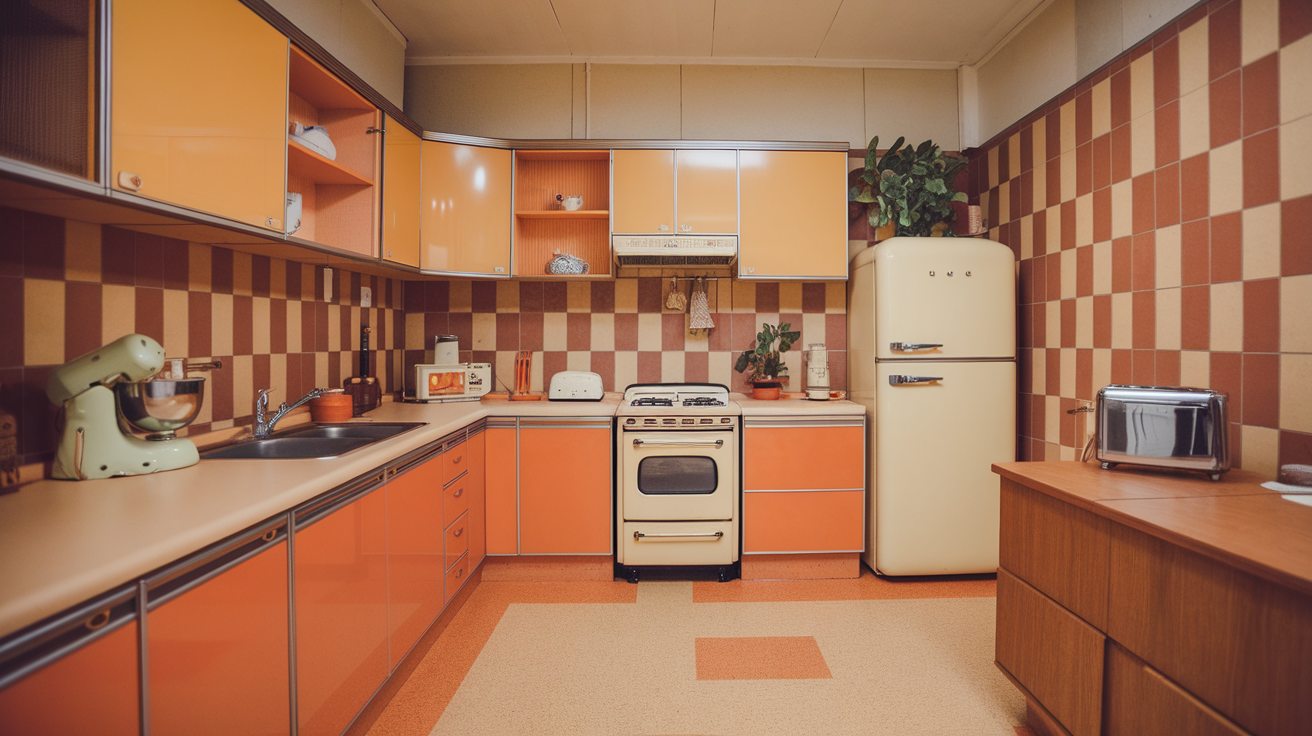I’ve always been drawn to the bold, expressive charm of 1970s kitchens.
From avocado green cabinets to funky tile backsplashes and wood-paneled walls, there’s something nostalgic yet surprisingly timeless about this retro style.
The mix of earthy tones, geometric patterns, and cozy textures creates a space that feels both creative and comforting.
If you’re renovating your kitchen or simply looking to add a few vintage-inspired touches, incorporating the ’70s vibe can make your space feel warm, personal, and full of character.
In this post, I’ll guide you through my favorite methods for capturing the essence of a 1970s kitchen, while keeping it functional and fresh for today’s lifestyle.
Why the 1970s Kitchen Is Making a Stylish Comeback?
The 1970s kitchen style is making a strong comeback because it offers a perfect blend of warmth, personality, and practicality. Many people today want homes that feel cozy and inviting, yet visually interesting, a quality that the ’70s aesthetic delivers with ease.
- Bold Colors and Playful Patterns: The 1970s were characterized by vibrant shades like avocado green, burnt orange, and mustard yellow, often paired with funky geometric or floral patterns.
- Warm, Earthy Tones: Alongside bright colors, warm neutrals like browns and tans create a grounded, natural feel that makes the space welcoming and comforting.
- Durable and Practical Materials: Popular surfaces, such as laminate countertops and wood paneling, are not only retro-cool but also affordable and easy to maintain, making them perfect for busy modern kitchens.
- Nostalgia and Timeless Character: For many, the 1970s evoke fond memories of home and family, bringing a sense of charm and personality that new kitchens sometimes lack.
- Sustainability and Vintage Revival: Reusing or repurposing vintage furniture and decor aligns with today’s eco-friendly mindset, adding a unique style point.
By incorporating these elements, you can create a kitchen that feels fresh, inviting, and full of character.
Styling and Decorating a 1970s Kitchen
Learn how to bring retro charm, warmth, and personality to your kitchen, blending nostalgia with modern functionality effortlessly.
1. Signature Color Palettes of the 1970s Kitchen
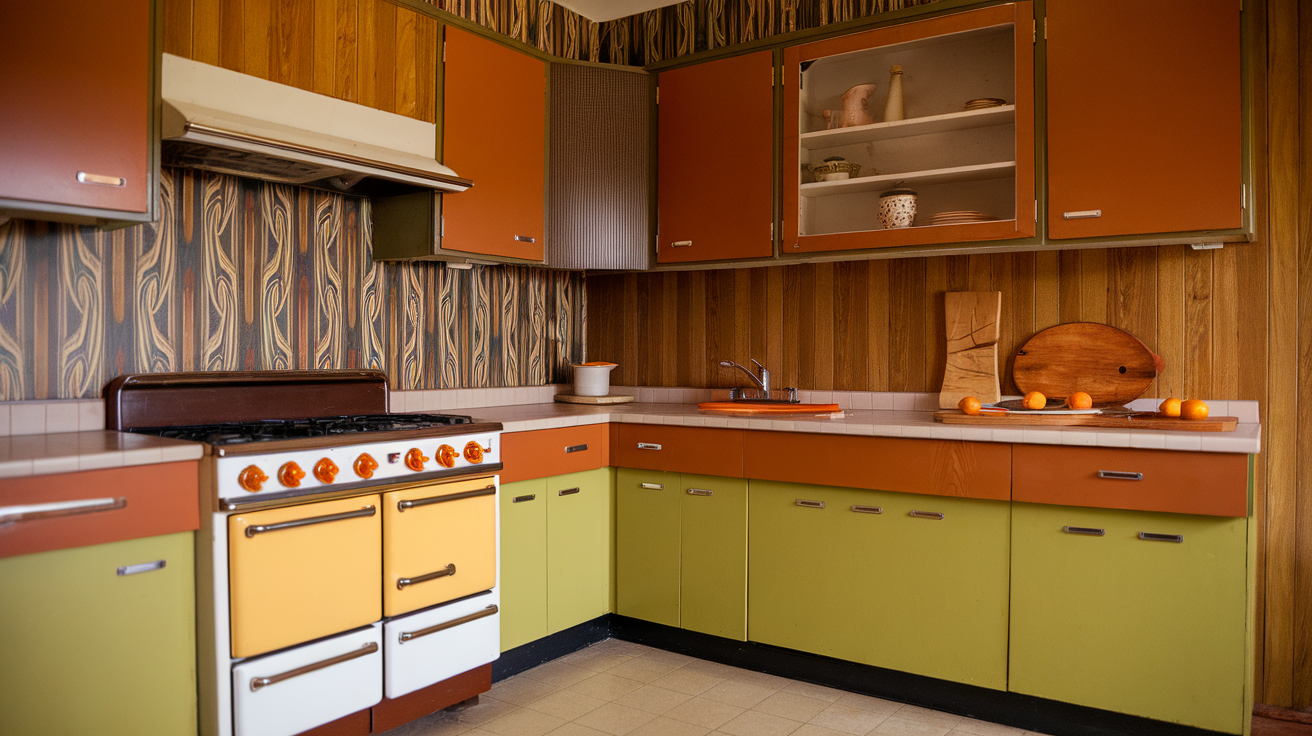
Classic 1970s kitchens employed warm, earthy tones and bold, vibrant colors to create inviting, energetic, and nostalgic spaces.
Popular color combinations: This includes avocado green with burnt orange, mustard yellow with brown, and harvest gold with deep reds, resulting in energetic, visually striking, and warm kitchen spaces.
Earthy vs. vibrant tones: Earthy tones like olive, mustard, and browns created grounded, natural vibes, while vibrant colors like orange, turquoise, and chartreuse added exciting, bold pops of energy to the space.
How to balance bold and neutral shades: Involves using neutrals like beige, cream, or wood on larger surfaces. This allowed the bold colors to stand out without overwhelming, ensuring harmony and warmth.
2. Bold Wallpaper Ideas Inspired by the ’70s
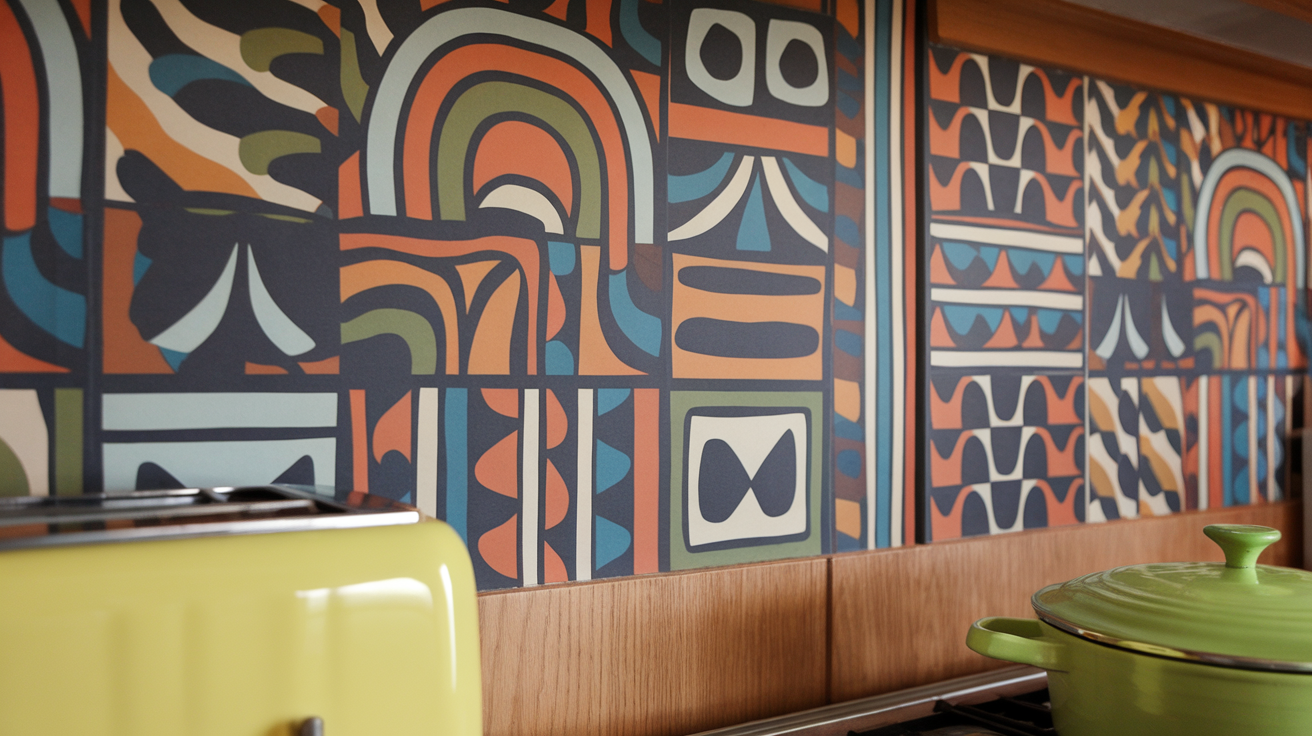
Wallpaper was a signature element of ’70s design, known for bold patterns and vivid motifs.
Popular choices include geometric shapes, psychedelic prints, and floral designs.
Combining wallpaper with other textures, such as wood paneling or tile, adds depth and interest.
Choosing one or two focal walls helps keep the look balanced and prevents visual overload while making a striking style statement.
3. Retro Patterns That Define the ’70s Aesthetic

Bold prints and playful motifs brought personality to 1970s kitchens, adding visual interest through walls, tiles, fabrics, and accessories.
Geometric and psychedelic prints: Bold geometric shapes and swirling psychedelic prints were a hallmark of the era. These patterns brought energy and personality into the kitchen.
Floral and nature-inspired motifs: Organic shapes like daisies, leaves, and vines softened the look of 1970s interiors. These motifs added a cheerful, earthy vibe, often used in wallpaper, table linens, and upholstery.
Using patterns on walls, tiles, and fabrics: Bold patterns on wallpaper, tiled backsplashes, and curtains were key design elements, creating cohesive, vibrant, and retro kitchen environments.
4. Iconic 1970s Kitchen Appliances and Fixtures

Bold colors, metallic accents, and sculptural forms made 1970s kitchen appliances and fixtures both functional and visually unforgettable.
Classic appliance colors and shapes: Avocado green, harvest gold, and burnt orange were the signature hues. Appliances featured rounded edges, boxy shapes, and a functional, space-age design.
Chrome and metallic finishes: Shiny chrome handles, trims, and accents were popular across appliances, cabinetry hardware, and small fixtures, adding a sleek, modern touch.
Retro lighting and faucets: Pendant lights, globe fixtures, and unique faucet shapes with metallic finishes added style and character to the space.
5. Bold Tiles and Backsplashes to Capture the Era
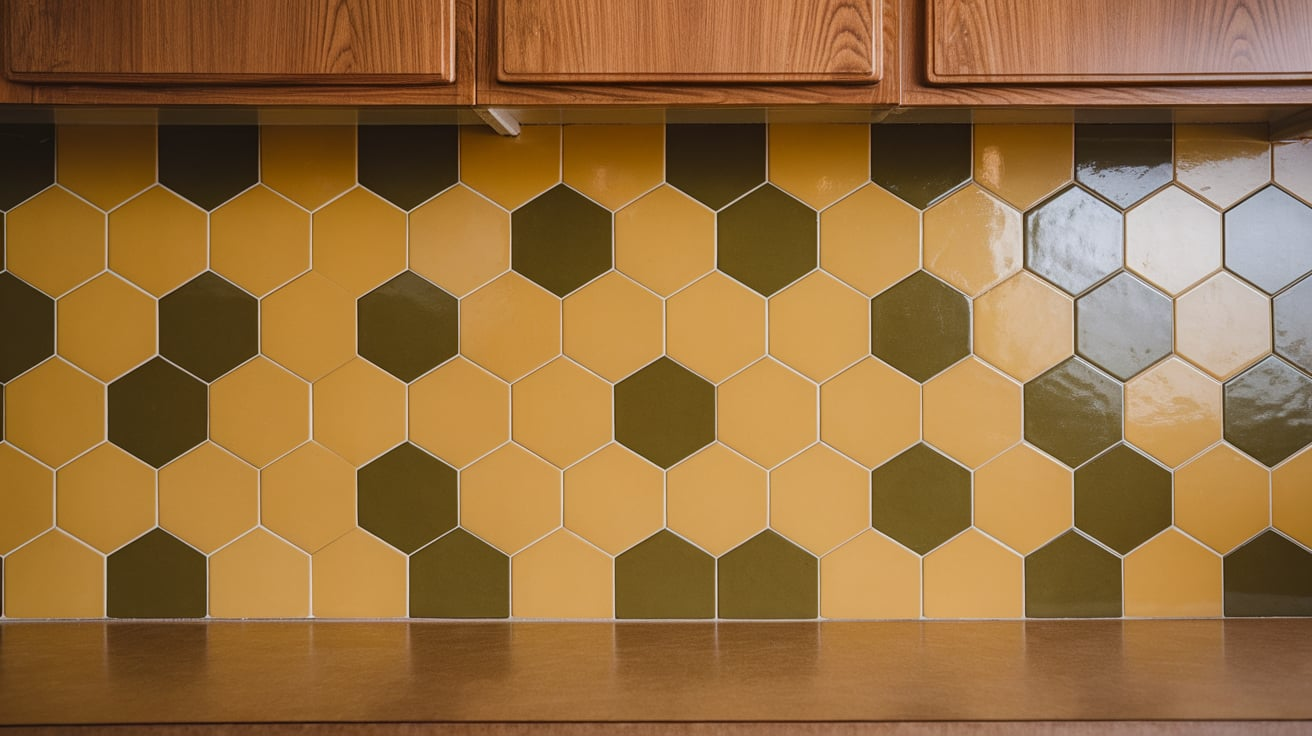
Tiles and backsplashes in 1970s kitchens were all about making a statement.
Popular tile shapes included squares, rectangles, and hexagons, often in larger sizes for a bold look.
Color was key; mustard yellow, burnt orange, olive green, and deep browns were frequently used in patterned or solid tile arrangements.
Tiles were also combined with other textures, such as wood paneling or laminate counters, to create visual contrast and depth.
This playful mix of patterns, colors, and textures gave 1970s kitchens their unmistakable retro flair.
6. Materials and Textures in Vintage Kitchens
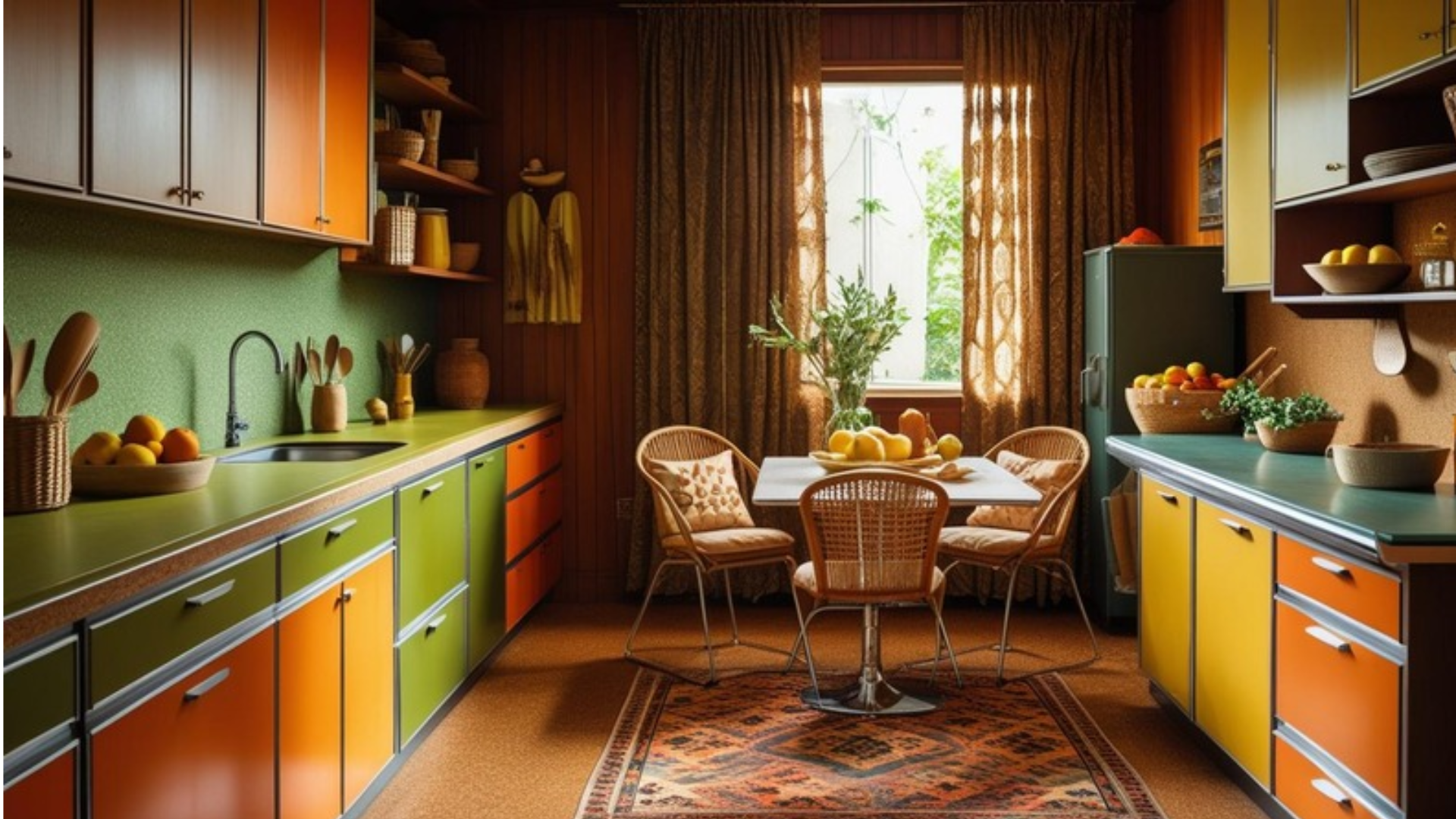
From sleek laminate and wood paneling to natural cork and rattan, combined with soft fabrics and woven baskets, these elements brought both function and handcrafted charm to vintage kitchen spaces.
Laminate and wood paneling: Laminate countertops and cabinetry were practical, sleek, and easy to clean. Paired with warm wood paneling, they created a welcoming, balanced kitchen space typical of the ’70s.
Natural materials: Cork flooring and rattan chairs introduced organic textures, adding warmth and a tactile quality. These natural materials enhanced the cozy, earthy feel of vintage kitchens.
Textured fabrics and baskets: Heavy curtains, tufted cushions, and patterned rugs added comfort and softness. Woven baskets provided functional storage, contributing to the era’s charming, handcrafted aesthetic.
7. Lighting Designs That Illuminate ’70s Kitchen Vibes

Lighting was a key feature in 1970s kitchens, blending style and function to create a warm, inviting atmosphere.
Pendant and globe lights with brass, chrome, or smoked glass finishes became iconic fixtures, adding sculptural interest above counters and tables.
Soft, warm lighting was favored to foster coziness, avoiding harsh brightness.
Layered lighting, which combines overhead fixtures with under-cabinet and accent lights, adds depth and flexibility, enhancing both ambiance and practicality.
8. Incorporate Vintage Linoleum Flooring
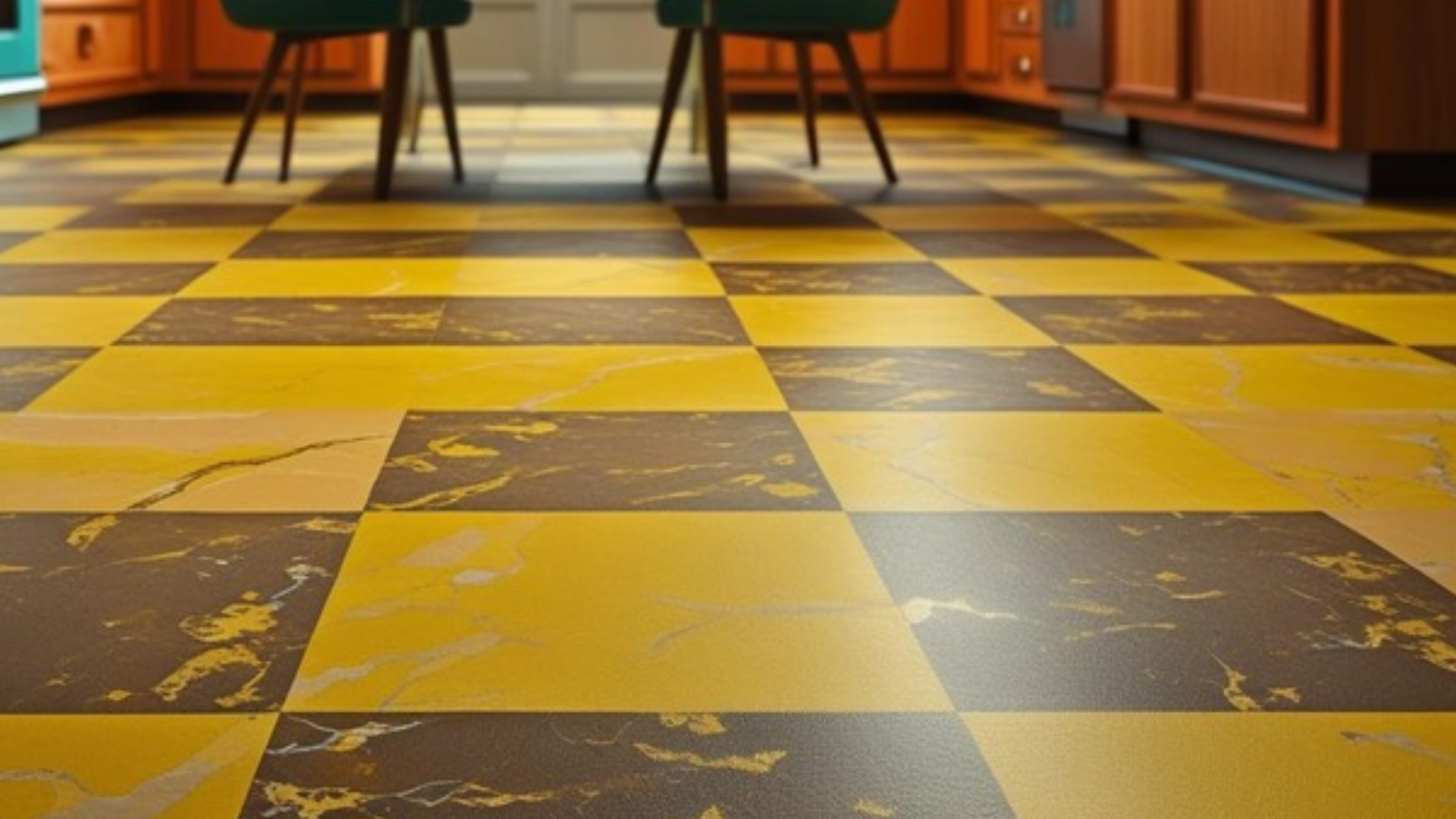
Vintage linoleum flooring was a staple in 1970s kitchens, known for its bold patterns and practicality.
Classic designs included checkered squares, marbled swirls, and geometric motifs that added instant character to the space.
Linoleum came in a range of retro colors, making it easy to coordinate with cabinetry, walls, and decor.
Beyond its visual appeal, linoleum was valued for being durable, low-maintenance, and budget-friendly.
Incorporating vintage-style linoleum today brings both charm and functionality, whether you go all-in or use it as a playful accent.
9. Furniture and Seating Styles from the 1970s
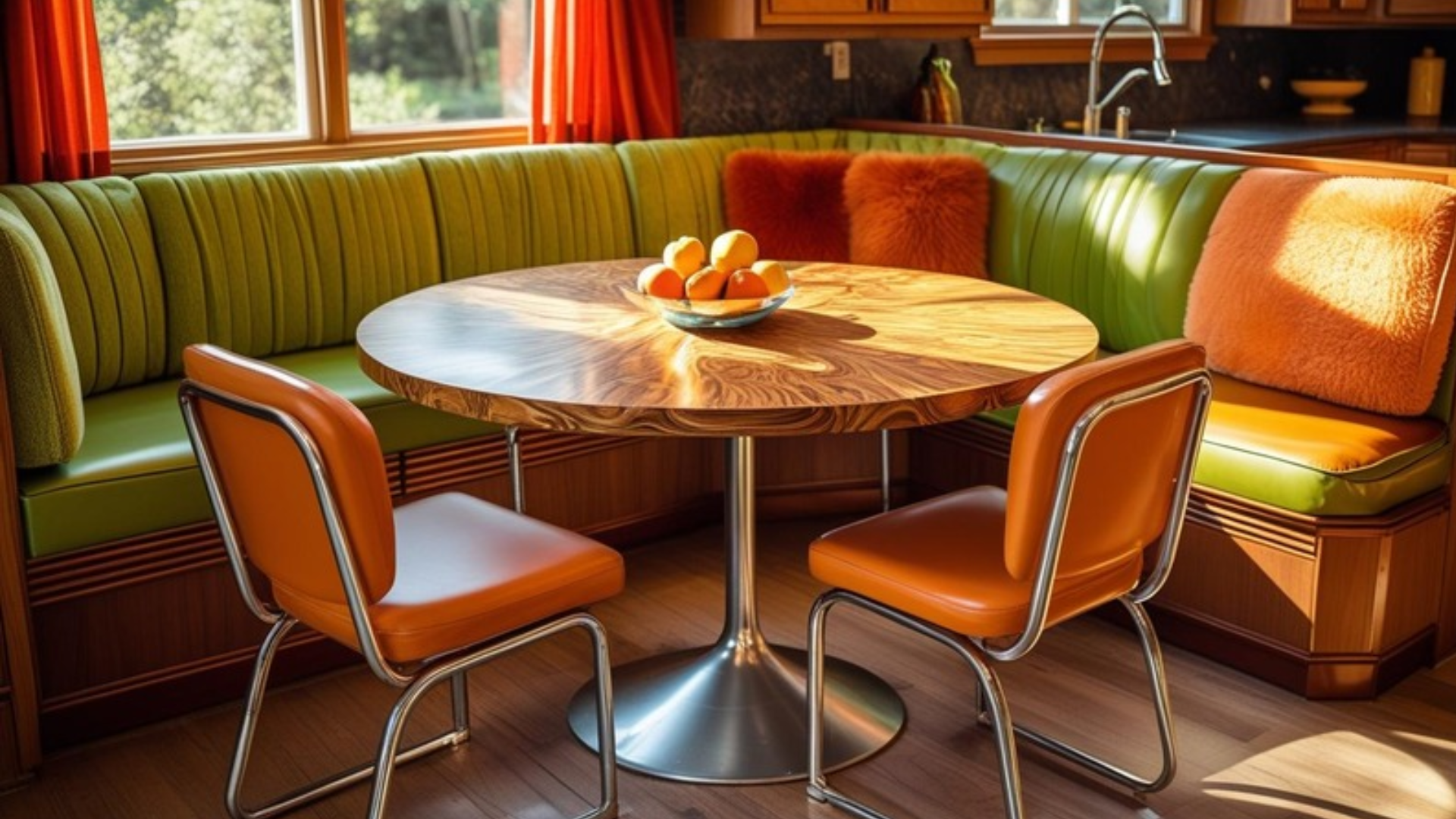
Vinyl and chrome chairs, round tables, and cozy booths defined 1970s kitchens. These furniture styles bring retro charm and comfort, blending vintage appeal with modern living spaces.
Vinyl and chrome chairs: Durable and easy to clean, vinyl and chrome chairs were kitchen staples. Their shiny finish and sleek design perfectly capture the retro 1970s style with practical comfort.
Round tables and booths: Built-in booths added cozy seating, creating intimate, inviting kitchen spaces that encouraged family and friends to gather comfortably.
Using furniture to add retro flair: Vintage furniture pieces instantly add authentic ’70s charm. Combining retro styles with modern touches helps create a balanced kitchen that feels both nostalgic and fresh.
10. Open Shelving and Display Trends in Retro Kitchens
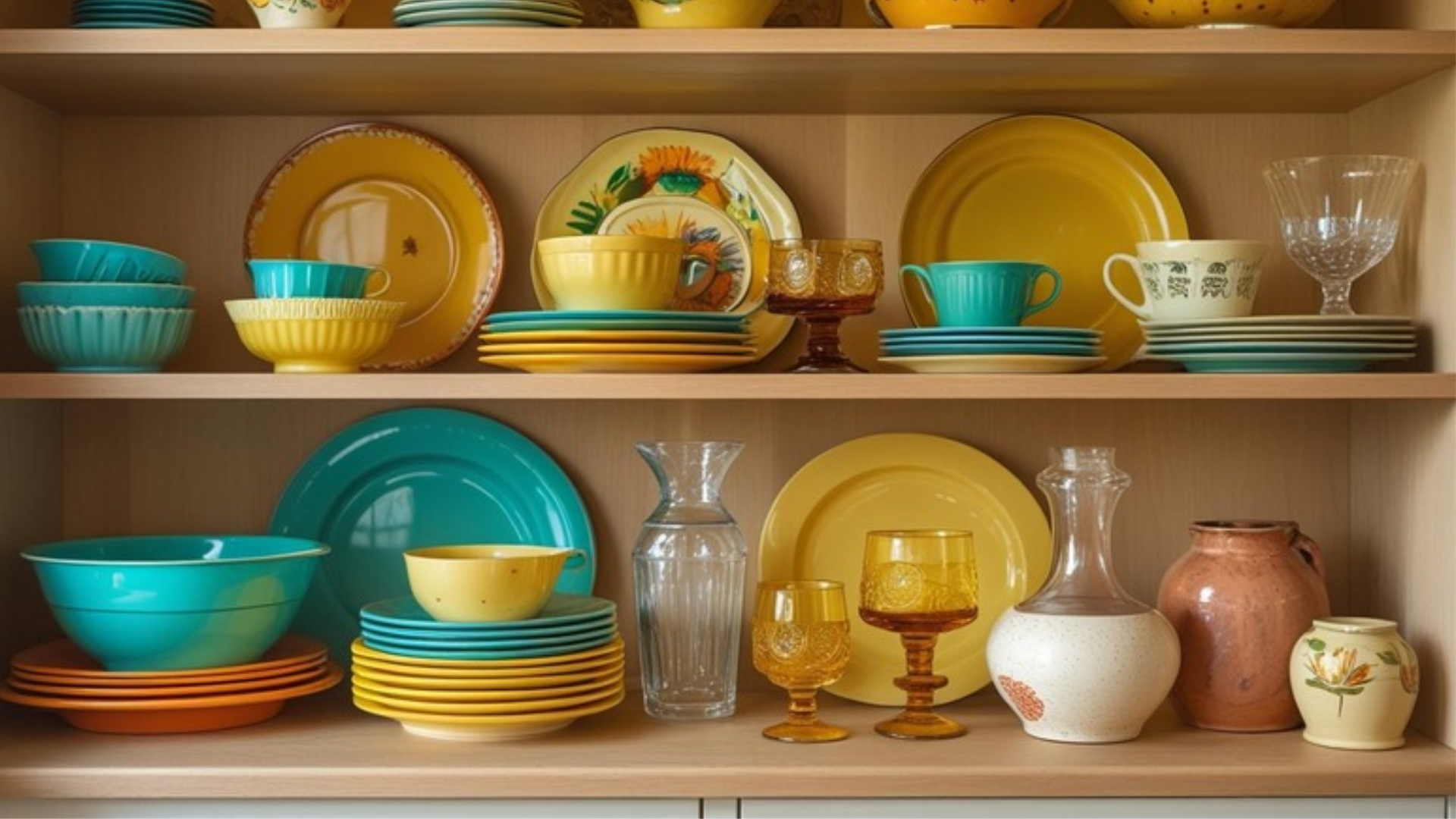
Open shelving was a popular way to showcase vintage kitchenware like colorful dishes, glassware, and pottery.
Styling shelves with carefully chosen retro items adds character while keeping the kitchen organized.
It’s essential to strike a balance between open displays and clutter, incorporating practical storage with decorative elements that evoke the ’70s aesthetic.
11. Decor Accessories That Bring 70s Kitchens to Life
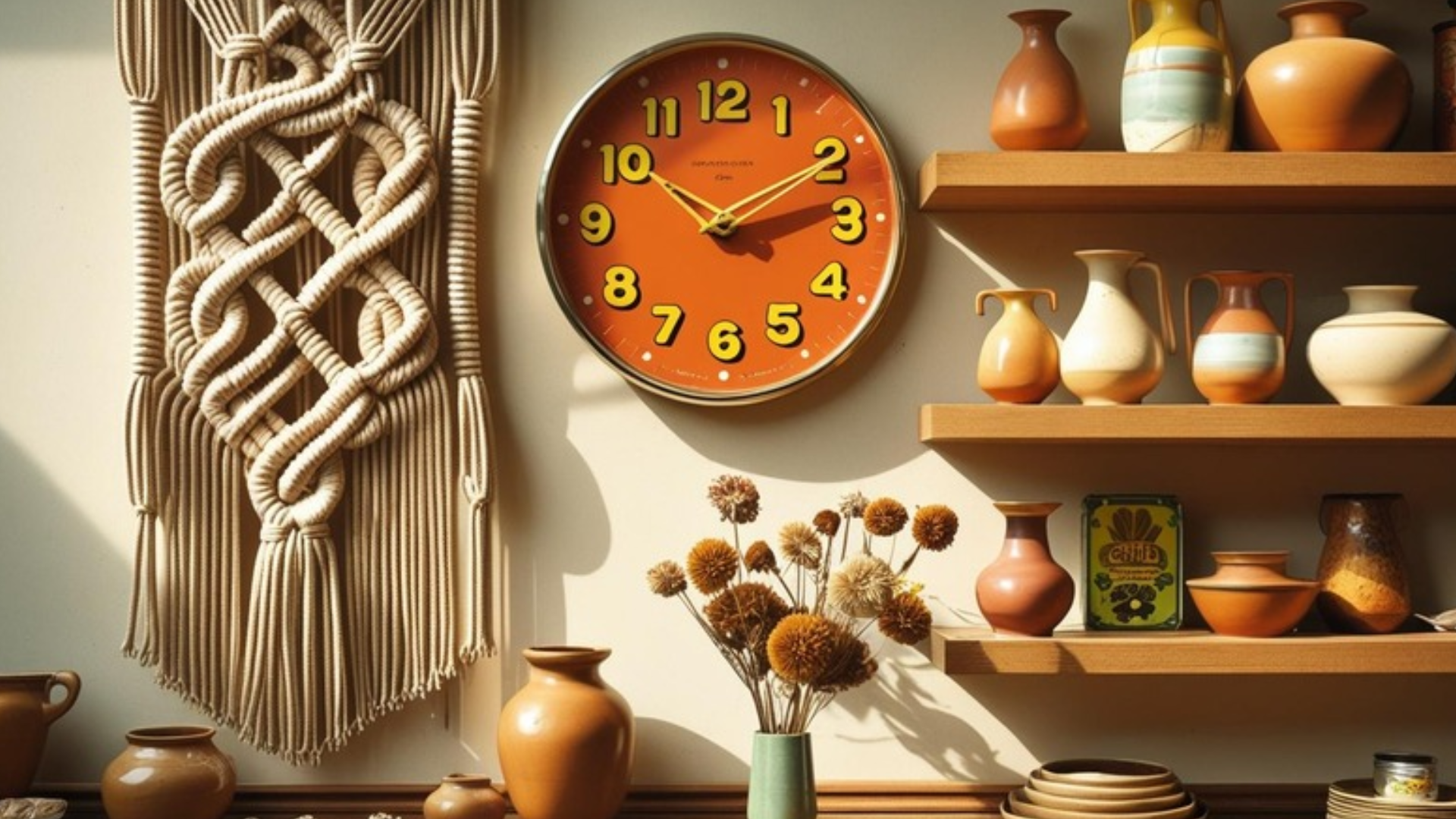
Decor accessories add authentic 1970s charm, layering texture, color, and personality to kitchens, making the space feel lively and nostalgic.
Macramé and textile art: Handmade macramé wall hangings and textile pieces added texture and bohemian flair, popular in ’70s kitchens.
Vintage clocks and signs: Bold, colorful clocks and retro signs brought character and nostalgic charm to the space.
Decorative ceramics and pottery: Earth-toned ceramics and pottery added warmth and artisanal style, enhancing the vintage vibe.
12. Incorporating Vintage Glassware and Ceramics
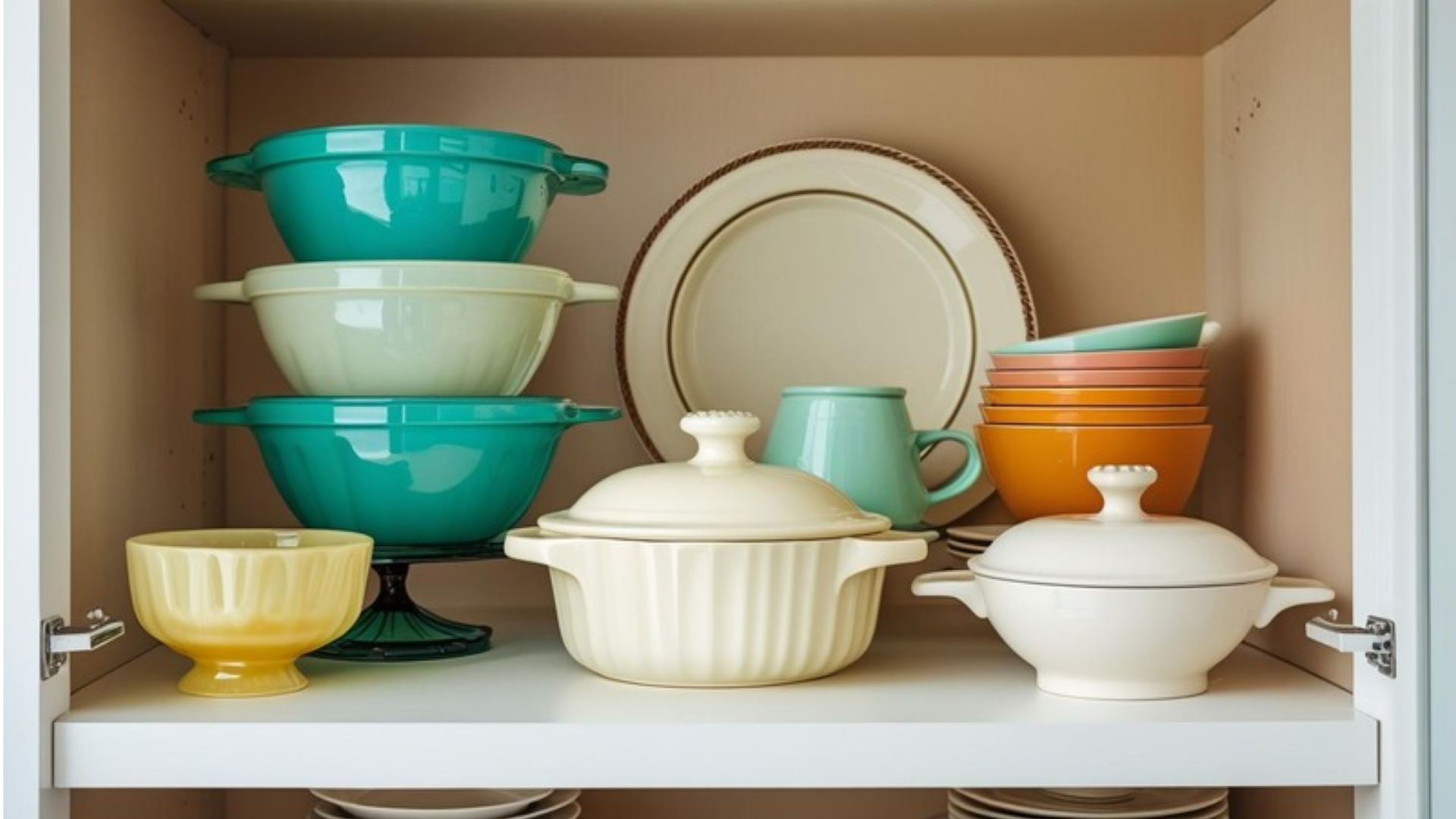
Vintage glassware and ceramics are essential for capturing authentic 1970s kitchen style.
Collecting iconic patterns and brands like Pyrex and Fire-King adds timeless appeal.
These glass pieces are perfect for display on open shelves, blending beauty and function.
Mixing vintage ceramics with modern tableware creates a curated look that balances nostalgia with contemporary practicality, making kitchens both stylish and functional.
13. Showcasing Retro Art and Posters in Kitchen Spaces
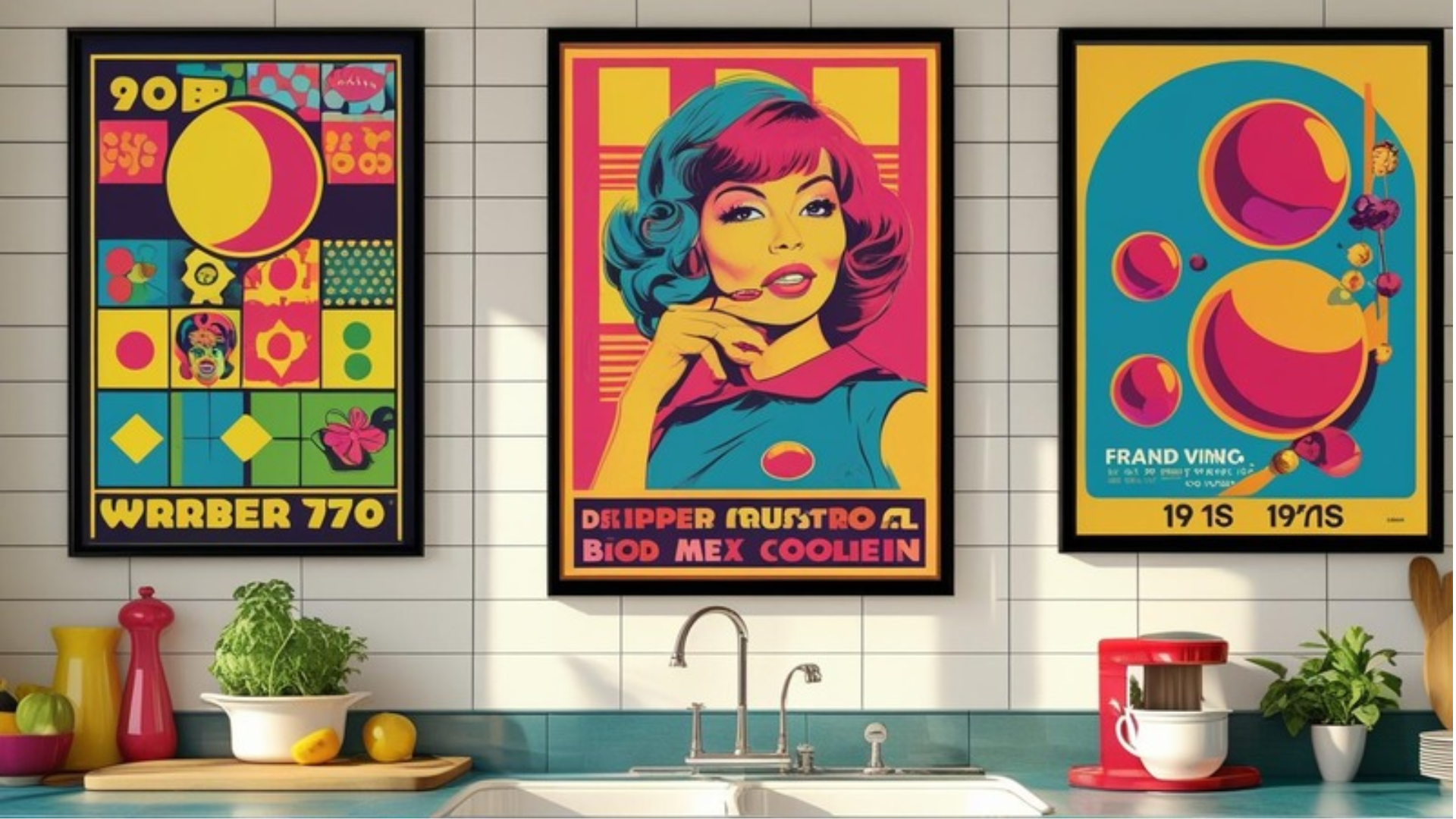
Choosing bold, vintage-style prints and arranging them thoughtfully creates a lively gallery wall.
Choosing vintage-style prints and posters: Select prints with bold, saturated colors, funky 1970s graphics, pop art influences, or vintage advertising themes to capture the authentic retro vibe.
Framing and placement tips: Use quality frames that complement the artwork and carefully plan placement to create a cohesive, polished look on your kitchen walls.
Creating a gallery wall with retro pieces: Group several artworks together in a gallery-style arrangement to maximize visual interest and infuse your kitchen with vibrant, nostalgic energy.
14. Using Plants and Natural Elements to Soften Retro Spaces
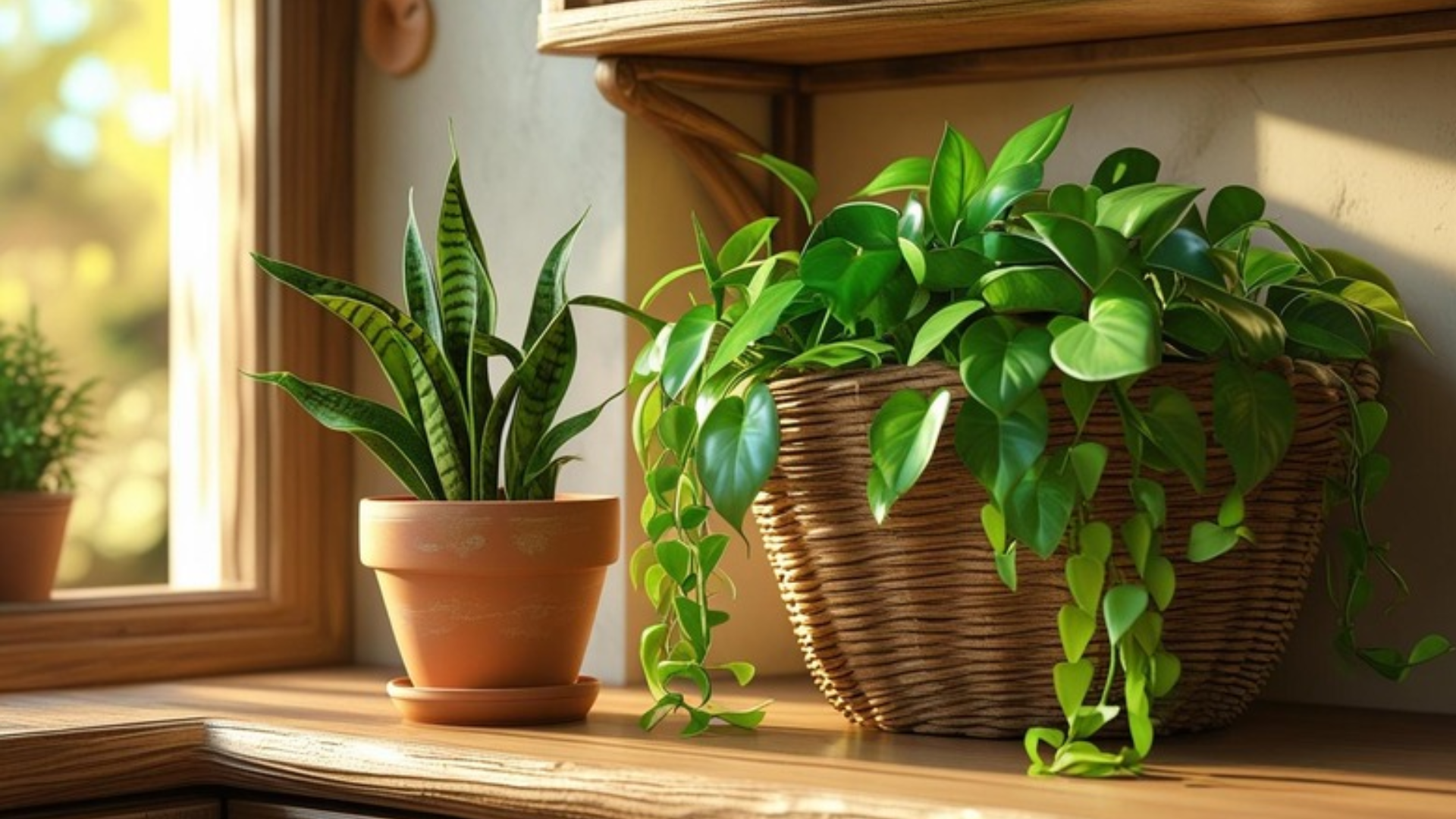
Incorporating plants and natural elements helps soften the bold, sometimes busy look of ’70s kitchens.
Easy-to-care-for plants like pothos, snake plants, and herbs thrive in kitchen environments while adding fresh greenery.
Choosing natural planters made from materials like terracotta, woven baskets, or ceramic pots complements the vintage vibe.
Thoughtful arrangement of plants creates visual balance and warmth, making the space feel inviting and connected to nature.
How to Maintain and Restore Vintage Kitchen Appliances
Vintage kitchen appliances bring timeless charm to your home, but they need special care to stay functional and safe. This is how to keep them in great shape:
- Clean gently: Use non-abrasive cleaners to protect original finishes, such as enamel, chrome, or painted surfaces.
- Inspect electrical parts: Check cords, plugs, and wiring for any signs of damage. Replace any worn components with safe, compatible parts.
- Lubricate moving parts: Keep hinges, motors, and gears running smoothly with food-safe lubricants to prevent rust and wear.
- Use original manuals or experts: Refer to vintage manuals or consult specialists for accurate repairs and troubleshooting.
- Prioritize safety: Test appliances carefully after repairs and call in a professional for complex or gas-powered models.
Restoring vintage appliances blends beauty and function. With a little effort and the right care, you can enjoy their retro appeal for years to come.
Common Mistakes to Avoid When Styling a ’70s Kitchen
Styling a ’70s kitchen is fun but tricky. Avoid overwhelming patterns, poor lighting, and non-functional appliances to keep the space cozy and practical.
- Too many bold patterns: Using multiple loud prints can overwhelm the space and create visual clutter, rather than achieving a cohesive look.
- Poor lighting choices: Insufficient or harsh lighting detracts from the warm, inviting atmosphere typically associated with ’70s kitchens.
- Ignoring modern convenience: Focusing solely on retro style without modern updates may make the kitchen impractical for daily use.
- Forcing complete authenticity can feel outdated; instead, blending vintage with modern elements creates a balanced look.
- Lack of balance: Failing to mix colors, textures, and furniture properly can disrupt harmony and diminish the kitchen’s appeal.
Conclusion
Bringing a 1970s kitchen back to life is more than just a design choice; it’s about embracing a time when style was bold, fun, and full of personality.
I love how this era combines earthy tones, graphic patterns, and cozy textures to create a space that feels welcoming and unique.
You can go all-in with retro appliances and funky wallpaper, or add a few vintage touches, such as macramé and wood accents, to capture that groovy charm.
The beauty of ’70s style lies in its effortless blending with modern comforts.
Ready to start your throwback kitchen journey?
Leave a comment with your favorite ’70s feature, or visit the Retro Kitchen Shop to find pieces that perfectly match your style.

